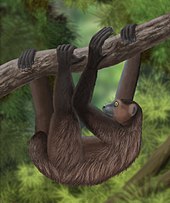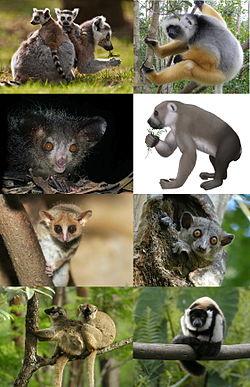
Lemurs (/ˈliːmər/ (listen) LEE-mər) are a clade of strepsirrhine primates endemic to the island of Madagascar. The word lemur derives from the word lemures (ghosts or spirits)
from Roman mythology and was first used to
describe a slender loris due to its nocturnal habits and slow pace, but was later applied to the
primates on Madagascar. As with other strepsirrhine primates, such as lorises, pottos, and galagos (bush babies), lemurs share resemblance with basal primates. In this regard,
lemurs are often confused with ancestral primates, when in actuality, lemurs
did not give rise to monkeys and apes, but evolved independently.
Due to
Madagascar's highly seasonal climate, lemur evolution has
produced a level of species diversity rivaling
that of any other primate group. Until shortly after humans arrived on the
island around 2,000 years ago, there were lemurs as large as a male gorilla. Today, there
are nearly
100 species of lemurs, and most of those species have been discovered or
promoted to full species status since the 1990s; however, lemur taxonomic
classification is controversial and depends on which species concept is
used. Even the higher-level taxonomy is disputed, with some experts preferring
to place most lemurs within the infraorder Lemuriformes, while
others prefer Lemuriformes to contain all living strepsirrhines, placing all
lemurs in the superfamily Lemuroidea and all lorises and galagos in
the superfamily Lorisoidea.
Ranging
in weight from the 30-gram (1.1 oz) mouse lemur to the
9-kilogram (20 lb) indri,
lemurs share many common, basal primate traits, such as divergent digits on their
hands and feet and nails instead
of claws (in most
species). However, their brain-to-body
size ratio is smaller than that of anthropoid primates, and among many
other traits they share with other strepsirrhine primates, they have a
"wet nose" (rhinarium).
Lemurs are generally the most social of the strepsirrhine primates and
communicate more with scents and vocalizations than with visual signals. Many
lemur adaptations are in response to Madagascar's highly seasonal environment.
Lemurs have relatively low basal metabolic rates and
may exhibit seasonal
breeding, dormancy (such
as hibernation or torpor), or female social
dominance. Most eat a wide variety of fruits and leaves, while some are
specialists. Although many share similar diets, different species of lemur
share the same forests by differentiating
niches.
Lemur
research during the 18th and 19th centuries focused on taxonomy and specimen
collection. Although field observations trickled in from early explorers,
modern studies of lemur ecology and behavior did not begin in earnest until the
1950s and 1960s. Initially hindered by political instability and turmoil on
Madagascar during the mid-1970s, field studies resumed in the 1980s and have
greatly increased the understanding of these primates. Research facilities like
the Duke Lemur
Center have provided research opportunities under more controlled
settings. Lemurs are important for research because their mix of ancestral
characteristics and traits shared with anthropoid primates can yield insights
on primate and human
evolution. However, many lemur species are threatened with extinction due
to habitat loss and hunting. Although local traditions generally help protect
lemurs and their forests, illegal
logging, widespread poverty, and political instability hinder and undermine
conservation efforts. Because of these threats and their declining numbers,
the International
Union for Conservation of Nature (IUCN) considers lemurs to be the
world's most endangered mammals, noting that—as of 2013—up to 90% of all lemur
species face extinction within the next 20 to 25 years.
Etymology
Carl Linnaeus, the
founder of modern binomial
nomenclature, gave lemurs their name as early as 1758, when he used it in
the 10th
edition of Systema Naturae. He
included three species under the genus Lemur: Lemur tardigradus (the red slender loris,
now known as Loris tardigradus), Lemur catta (the ring-tailed lemur),
and Lemur volans (the Philippine colugo,
now known as Cynocephalus volans).
Lemures dixi hos, quod noctu imprimis obambulant,
hominibus quodanmodo similes, & lento passu vagantur.
[I call
them lemurs, because they go around mainly by night, in a certain way similar
to humans, and roam with a slow pace.]
Linnaeus, Museum Adolphi Friderici Regis
in
reference to the red
slender loris
Although
the term "lemur" was first intended for slender lorises, it was
soon limited to the endemic Malagasy
primates, which have been known as "lemurs" ever since. The name
derives from the Latin term lemures, which
refers to specters or ghosts that were exorcised during
the Lemuria
festival of ancient Rome. According to Linnaeus' own explanation,
the name was selected because of the nocturnal activity and slow movements of
the slender loris. Being familiar with the works of Virgil and Ovid and seeing an analogy
that fit with his naming scheme, Linnaeus adapted the term "lemur"
for these nocturnal primates. However, Dunkel et al. noted in 2012 that it has been commonly and falsely
assumed that Linnaeus was referring to the ghost-like appearance, reflective eyes, and
ghostly cries of lemurs. It has also been speculated that Linnaeus may
also have known that some Malagasy people have held legends that lemurs are the
souls of their ancestors, but this is unlikely given that the name was
selected for slender lorises from India, according to Dunkel et al.
Evolutionary
history
Lemurs
are primates belonging to the suborder Strepsirrhini. Like
other strepsirrhine primates,
such as lorises, pottos, and galagos, they share ancestral
(or plesiomorphic)
traits with early primates. In this regard, lemurs are popularly confused with
ancestral primates; however, lemurs did not give rise to monkeys and apes (simians). Instead, they evolved
independently in isolation on Madagascar. All
modern strepsirrhines including lemurs are traditionally thought to have
evolved from early primates known as adapiforms during
the Eocene (56 to
34 mya)
or Paleocene (66
to 56 mya). Adapiforms, however, lack a specialized arrangement of
teeth, known as a toothcomb,
which nearly all living strepsirrhines possess. A more recent hypothesis is that
lemurs descended from lorisoids (loris-like) primates. This is supported by
comparative studies of the cytochrome bgene and
the presence of the strepsirrhine toothcomb in both groups. Instead of being
the direct ancestors of lemurs, the adapiforms may have given rise to both the
lemurs and lorisoids, a split that would be supported by molecular
phylogenetic studies. The later split between lemurs and lorises
is thought to have occurred approximately 62 to 65 mya according to
molecular studies, although other genetic tests and the fossil record in
Africa suggest more conservative estimates of 50 to 55 mya for this
divergence. However, the oldest lemur fossils on Madagascar are actually subfossils dating to
the Late
Pleistocene.
Once
part of the supercontinent Gondwana,
the island of Madagascar has been isolated since it broke away from
eastern Africa (~160 mya), Antarctica (~80–130 mya),
and India(~80–90 mya). Since
ancestral lemurs are thought to have originated in Africa around 62 to
65 mya, they must have crossed the Mozambique Channel,
a deep channel between Africa and Madagascar with a minimum width of about
560 km (350 mi). In 1915, paleontologist William Diller
Matthew noted that the mammalian biodiversity on Madagascar (including
lemurs) can only be accounted for by random rafting events, where
very small populations rafted from nearby Africa on tangled mats of vegetation,
which get flushed out to sea from major rivers. This form of biological dispersal can
occur randomly over millions of years. In the 1940s, American
paleontologist George Gaylord
Simpson coined the term "sweepstakes hypothesis" for such
random events. Rafting has since been the most accepted explanation for
the lemur colonization of Madagascar, but until recently this trip was
thought to be very unlikely because strong ocean currents flow
away from the island. In January 2010, a report demonstrated that around
60 mya both Madagascar and Africa were 1,650 km (1,030 mi) south
of their present-day positions, placing them in a different ocean gyre, producing
currents that ran counter to what they are today. The ocean currents were shown
to be even stronger than today, which would have pushed a raft along faster,
shortening the trip to 30 days or less—short enough for a small mammal to
survive easily. As the continental plates drifted
northward, the currents gradually changed, and by 20 mya the window for
oceanic dispersal had closed, effectively isolating the lemurs and the rest of
the terrestrial Malagasy fauna from mainland Africa. Isolated on Madagascar
with only a limited number of mammalian competitors, the lemurs did not have to
compete with other evolving arboreal mammalian
groups, such as squirrels. They
were also spared from having to compete with monkeys, which evolved later.
The intelligence, aggression, and deceptiveness of monkeys gave them an
advantage over other primates in exploiting the environment.
Distribution and diversity
Lemurs
have adapted to
fill many open ecological
niches since making their way to Madagascar. Their diversity in both
behavior and morphology (outward appearance) rivals that of the monkeys and
apes found elsewhere in the world. Ranging in size from the 30 g
(1.1 oz) Madame
Berthe's mouse lemur, the world's smallest primate, to the recently
extinct 160–200 kg (350–440 lb) Archaeoindris fontoynonti, lemurs
evolved diverse forms of locomotion, varying levels of social complexity, and
unique adaptations to the local climate.
Lemurs
lack any shared traits that make them stand out from all other
primates. Different types of lemurs have evolved unique combinations of
unusual traits to cope with Madagascar's harsh, seasonal climate. These traits
can include seasonal fat storage, hypometabolism (including torporand hibernation), small group
sizes, low encephalization (relative
brain size), cathemerality (activity
both day and night), and strict breeding seasons. Extreme
resource limitations and seasonal breeding are also thought to have given rise
to three other relatively common lemur traits: female social
dominance, sexual monomorphism, and male–male competition for mates
involving low levels of agonism, such
as sperm
competition.
Before
the arrival of humans roughly 1500 to 2000 years ago, lemurs were found
all across the island. However, early settlers quickly converted the
forests to rice
paddies and grassland through slash-and-burn agriculture (known
locally as tavy), restricting
lemurs to approximately 10% of the island's area, ~60,000 km2 (23,000 sq mi). Today, the
diversity and complexity of lemur communities increases with floral diversity and precipitation and
is highest in the rainforests of
the east coast, where precipitation and floral diversity are also at their
highest. Despite their adaptations for weathering extreme adversity,
habitat destruction and hunting have resulted in lemur populations declining
sharply, and their diversity has diminished, with the recent extinction of at
least 17 species in eight genera, known collectively as the subfossil lemurs. Most
of the approximately 100 species and subspecies of lemur are either
threatened or endangered. Unless trends change, extinctions are likely to
continue.
Until
recently, giant lemurs existed on Madagascar. Now represented only by recent or
subfossil remains, they were modern forms that were once part of the rich lemur
diversity that has evolved in isolation. Some of their adaptations were unlike
those seen in their living relatives. All 17 extinct lemurs were
larger than the extant (living) forms, some weighing as much as 200 kg
(440 lb), and are thought to have been active during the day. Not
only were they unlike the living lemurs in both size and appearance, they also
filled ecological niches that either no longer exist or are now left
unoccupied. Large parts of Madagascar, which are now devoid of forests and
lemurs, once hosted diverse primate communities that included more than
20 lemur species covering the full range of lemur sizes.
